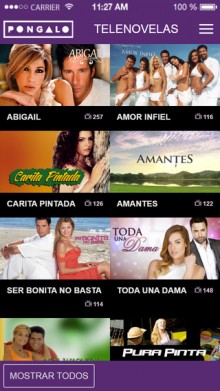
Telenovela fans have a new destination: Pongalo, which means “Play it” in Spanish. Available both on the Web and on mobile devices (iOS and Android), its beta version boasts a catalogue of 50,000 hours of Spanish-language television, film and children’s content, which viewers can stream for free with ads.
Most of this catalogue comes from Venezuelan content powerhouse RCTV (Radio Caracas Televisión), which is owned by the family of Jorge Granier, director of RCTV International and CEO of Pongalo’s parent company Latin Everywhere.
As some of you may remember, Latin Everywhere was formed in October through the merger of Granier’s former company GoTV and another company called Latin Anywhere, whose founder Rich Hull is now executive chairman of the new entity.
The platform’s infrastructure is provided by content streaming startup Inmoo, a company Latin Everywhere acquired last month. One of its main roles will be to enable Pongalo’s presence on multiple devices, which will be crucial if it wants to reach its goal to become the ‘Hulu for Hispanics.’
According to Nielsen, 60 percent of all US Hispanic households own an Internet-enabled smartphone, compared to just 43 percent for the general population.
Ultimately, Pongalo hopes to reach Spanish-speaking viewers anywhere in the world, and provide all of them with the type of content they want to watch. It’s a task Granier has been quite successful at in the past, both as a filmmaker and as an industry executive — he’s executive producer of CW’s series “Jane the Virgin,” adapted from RCTV’s “Juana la Virgen.”
Here’s our interview with him:
TNW: Why did it make sense for your previous company GoTV and Latin Anywhere to merge last year? How would you describe the new, post-merger Latin Everywhere in a few words?
JG: It made sense for LAI [Latin Anywhere Inc.] and us to merge because we were both gathering assets in the Spanish language digital space. LAI was more focused on films and GoTV more so on TV, LAI had a bigger distributor network in the US and GoTV a larger presence internationally, particularly Latin America; so you start to see why it made sense for us to come together.
Post-merger Latin Everywhere has now one of the largest digital Spanish libraries in the world; it also operates a fast growing YouTube MCN [multi-channel network] and has distribution agreements with the top digital players around the world.
TNW: What is Pongalo’s backstory as a YouTube channel and how did it lead to its current relaunch as a standalone streaming platform?
JG: Pongalo began as a test site for our content, to see if we could find an audience. We saw as it quickly grew around a community of highly engaged fans, so through more channels it became a network, once we had a significant audience (50mm view per month – now 60mm views per month) we decided it made sense to launch our own standalone streaming platform where we give the fans a customized experience that they can enjoy anywhere, anytime.
TNW: What content can viewers find on Pongalo and where does it come from? How do you plan to expand its catalogue while maintaining worldwide streaming rights?
JG: Viewers can find telenovelas from Venezuela and Colombia and we are adding more titles from more places monthly. In the next weeks we will add a movie vertical where they will find all kinds of Latin American films, after that we plan on adding one or two more verticals with more content that speaks to our fans.

TNW: What are some of the key points that make Pongalo different from its competitors, such as Direct TV’s Yaveo?
JG: First is the size of the catalog: we have more content than anyone out there so far. But content alone is not enough, so we keep adding more and we also focused on a simple, easy to use, user experience.
In the case of Yaveo, it is an SVOD [subscription-supported video on demand] platform, we launched with an AVOD [ad-supported video on demand] model and will add SVOD in the future. We also have focused on the audience we know best which is the telenovela fan, and we’ll add content that’s relevant to them.
TNW: Why did you decide to start with an ad-supported model, rather than the premium catalogue you plan to add later on? How do you think those two offerings will work together?
JG: We believe in the dual model for streaming, we have a premium catalogue and are adding to it on a monthly basis. We also have our MCN where we have a highly engaged community of fans.
So I guess our decision comes from our assets and our audience or eyeballs and the particular situation we are in. We can give them a great ad-supported experience and as we grow and add more verticals and features we will give them the option to convert to a subscription model and access more and personalize their interaction more.
TNW: Pongalo is also available iOS and Android. Can you please share some numbers on the importance of mobile in your target audience?
JG: We have been able to gather great data from our fans and where they consume our content. Particularly interesting was the fact that more than 55 percent of them accessed our content from mobile devices, in some Latin American countries that number goes significantly up.
In the case of the operating system we see that more than 85 percent of those mobile users use Android. So by looking at the data we’ve been able to craft a product that’s truly relevant to them.


TNW: Why did you prefer to focus on Spanish-language content, at least initially? Some other players in this space, such as Fusion, decided to take a different approach and target US Hispanic viewers with English-language content.
JG: We target the Spanish language user worldwide, we see a void in this space at the moment and have amazing content to feature.
TNW: Your addressable market is spread out across several Spanish-speaking countries and the US. How do you plan to adapt your marketing strategy to this fact? Is Spain also part of your plans?
JG: I think the most important part of what we have and what we know is that we speak to the telenovela fan, no matter where they are. They now our product well and are highly engaged, we can also speak to them through our MCN community so that gives us an advantage as they are already seeking us out in all our social media platforms. And yes, we have a presence in Spain and plan on expanding on that as well.
TNW: How important do you think social media will be for Pongalo to attract viewers?
JG: Extremely important. One of our advantages is that we have developed our presence in social media brands by developing a community around the telenovela fan. In YouTube alone, we get 60mm views a month and have more than 6mm subscribers.
TNW: How does Pongalo fit into Latin Everywhere’s general strategy? Couldn’t it end up cannibalizing its network of YouTube channels?
JG: I think Pongalo is additive to the Latin Everywhere strategy which consists of content licensing, MCN growth and our streaming platform. Through them we reach different fans in different places with Pongalo being the super fan destination where they can get the most customizable viewer experience.
TNW: Why did Latin Everywhere decide to acquire Inmoo?
JG: We searched a lot for the right platform and found that Inmoo had the type of simple but highly scalable tech that we needed. It also helped that it was founded by longtime entrepreneurs with great connections in the video streaming world.
TNW: Will Pongalo become available through other platforms and devices in the near future?
JG: Yes, we will be adding more platforms and devices on a monthly basis, so you will see Pongalo in more Smart TVs, boxes and operating systems in the near future.
Image credit: Pond5
Get the TNW newsletter
Get the most important tech news in your inbox each week.




